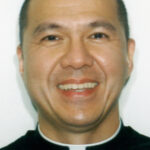
Juan Diego kneeling in prayer
By Lindsay Steele
The Catholic Messenger
Juan Diego Cuauhtlatoatzin was walking to the place where he received catechetical instruction when Mary appeared to him Dec. 9, 1531, on Tepeyac Hill, the site of a former pagan temple near Mexico City. Speaking in Juan Diego’s native Nahuatl language, she asked him to petition the bishop to build a shrine there.
The bishop listened to Juan Diego, an indigenous man of modest means, but did not immediately believe him. Juan Diego returned to Our Lady and told her that she should choose a better messenger. She was adamant that she had chosen the correct messenger and so he returned to the bishop a second time. The bishop asked for a sign.
Mary told Juan Diego to return the next day. His uncle fell gravely ill, however, and Juan Diego stayed home to care for him. Although Juan Diego attempted to avoid Mary, she found him and assured him that his uncle would recover. She asked Juan Diego to climb a hill where nothing but cactus and scrub brush grew and told him to pick the roses he would find there. He bundled the flowers in his tilma (cloak) and returned to the bishop.
“When Juan Diego opened his tilma, the bishop, wide-eyed, fell to his knees, for he beheld not only roses, but the image of a beautiful mestiza, or mixed-race girl, clothed like an Indian. She was ‘clothed with the sun, with the moon under her feet’ (Rev 12:1), as the Book of Revelation describes. The bishop understood: this humble Indian had really seen the Mother of God and Mother of all believers, who left her likeness imprinted on his mantle” (Vatican News).
As the indigenous people learned what had happened, they realized “that this Gospel, or good news, was also for them. By 1539, only eight years after the apparitions, some 9 million of them had asked for baptism,” according to Vatican News. Pope John Paul II beatified Juan Diego in 1990 and canonized him in 2002.
For Sister Irene Munoz, CHM, St. Juan Diego is an example of how God chooses ordinary people to do extraordinary things. “God uses the insignificant, poor and rejected individuals to be the messengers. … Often we are hesitant to listen to the Spirit and think someone could do it better than us. Juan Diego’s story brought many people to believe in our God of Creation and our blessed Mother.”
Manny Toquinto, a lay leader at St. Anthony Parish in Davenport, said St. Juan Diego holds a special place in the hearts of people with Mexican heritage. “He would call himself ‘not an important person,’” but he “showed us the Holy Mother, Our Lady of Guadalupe.”
Toquinto believes Catholics today can learn from St. Juan Diego’s humility and obedience, especially during Advent. “He is a good example of waiting and hope,” believing in Mary’s apparitions and returning to the bishop even after rejection. St. Juan Diego “loved Our Lady so much that he decided to move to Tepeyac Hill to pray and work for her until he passed away.”

Sister Munoz encourages Catholics to ask St. Juan Diego for the “courage, fortitude and wisdom” to speak for people who are suffering and to strengthen devotion to Our Lady of Guadalupe “who is a symbol of hope, caring and love. Remember what she asked Juan Diego: ‘Am I not your mother?’ We can evangelize by sharing our stories with others about how our Creator and our Mother have touched our lives.”
St. Juan Diego’s story provides inspiration to people who do not think they have the power to approach and challenge authority figures, Sister Munoz believes. “We, too, are called to develop our faith so strongly and convincingly that we dare to challenge forces that are oppressive to all of us today. Our strong belief in Our Lady of Guadalupe and St. Juan Diego convinces us that we can begin to change oppressive structures and situations by relying on our faith and the gifts that our Creator has given us to speak boldly.”
“We, as followers of Christ, are called by our baptismal commitments to be the Juan Diegos of the world by speaking truth to power without fear,” she continued. “The Holy Spirit moves and touches us all to speak as anointed persons at baptism as priest, prophet and king.”











